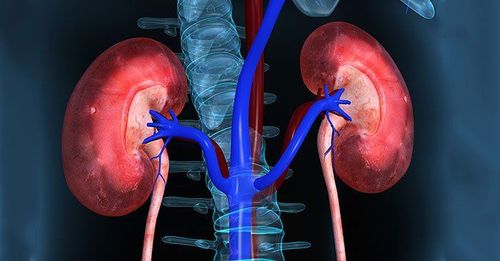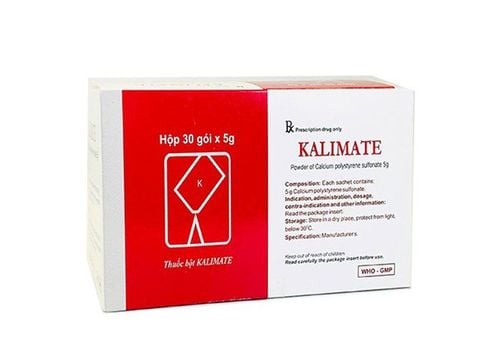This is an automatically translated article.
The article was professionally consulted with Doctor Vo Ha Bang Suong - General Internal Medicine - Department of Examination & Internal Medicine - Vinmec Phu Quoc International General HospitalPotassium is important for the function of nerve cells and muscles, including the heart muscle. Potassium electrolyte disturbances occur due to many different causes. Therefore, a blood potassium test is indicated by the doctor to check the health status, from which there is a direction for timely examination and treatment.
1. Overview of potassium and disorders of potassium levels in the body
Potassium is the predominant intracellular cation, but only 2% of total body potassium is extracellular. Since most of the intracellular potassium is contained in muscle cells, the amount of body potassium is equivalent to body mass without fat.Potassium is the main determinant of osmolarity in cells. The ratio of potassium concentration in the intracellular fluid to that in the extracellular fluid has an important influence on the cell membrane potential, which plays an important role in cellular activities such as nerve conduction and cell contraction. Therefore, small changes in serum potassium levels can have clinically significant implications. Serum potassium levels may be too high (hyperkalemia) or too low (hypokalemia) causing clinical symptoms ranging from mild to severe and possibly fatal.
In the absence of intracellular and extracellular potassium transfer factors, serum potassium concentration is strongly correlated with total body potassium. Once the intracellular and extracellular concentrations are stable, a decrease in serum potassium concentration of about 1 mEq/L indicates a total potassium deficiency of about 200 to 400 mEq. Patients with stable potassium levels <3 mEq/L often have significant potassium deficiency.
1.1. Potassium displacement Factors that shift potassium in or out of cells include:
Insulin concentration: Insulin moves potassium into cells: high insulin levels decrease serum potassium levels. Low insulin levels, as in diabetic ketoacidosis, cause extracellular potassium migration, sometimes with total body potassium deficiency. Beta-adrenergic activity: Beta-adrenergic agonists, especially selective beta 2 agonists, bring potassium into the cells, while beta blockers and alpha agonists promote potassium out of the cells. Acid-base status: Acute metabolic acidosis causes potassium to move out of cells, while metabolic alkalosis causes potassium to move into cells. However, the change in serum bicarbonate concentration may be more important than the change in pH; Acidosis caused by accumulation of inorganic acids (non-anion gap, hyperchloremic acidosis) may further increase serum potassium. In contrast, metabolic acidosis due to the accumulation of organic acids (increased aninone gap) does not cause hyperkalemia. Therefore, hyperkalemia is more common in diabetic ketoacidosis caused from insulin deficiency than from acidosis. Acidosis and acute respiratory alkalosis affect serum potassium less than metabolic acidosis. However, serum potassium should always be analyzed in terms of serum pH (and bicarbonate concentration). 1.2. Potassium metabolism The amount of potassium intake from the normal diet ranges from 40 - 150 mEq/day. At steady state, faecal potassium loss is usually less than 10% of intake, with the remaining 90% being excreted in the urine. Therefore, changes in renal potassium excretion greatly affect potassium balance.
When potassium intake is > 150 mEq/day, about 50% of excess potassium appears in the urine over the next few hours. Much of the remainder is transferred to the intracellular compartment, thereby minimizing the rise in serum potassium. As potassium intake continues to increase, aldosterone secretion is stimulated and renal potassium excretion increases. In addition, fecal potassium reabsorption occurs when dysregulation occurs and can be reduced by up to 50% in chronic potassium excess.
When potassium intake is reduced, intracellular potassium again provides a large buffer for serum potassium concentrations. Renal potassium conservation develops relatively slowly in response to dietary potassium reduction and is less effective than sodium-conserving renal. Therefore, potassium deficiency is often a frequent clinical problem. Urinary excretion of potassium of about 10 mEq/day indicates near-maximum renal potassium conservation and significant potassium deficiency.
Acute acidosis reduces potassium excretion, while chronic acidosis and acute alkalosis can promote potassium excretion. Increased sodium transfer to the distal tubule, as well as occurring with increased sodium intake or loop diuretics, promotes potassium excretion.
1.3.Pseudopotassial hypokalemia, or falsely low serum potassium, is sometimes found when a blood sample from a patient with chronic granulocytopenia and a white blood cell count >105/μL remains at temperature room temperature before handling, because abnormal white blood cells in the sample will pick up serum potassium. Prevent by rapidly separating plasma or serum in blood samples.
Pseudohyperkalemia or artificially elevated serum potassium are more common, usually occurring due to hemolysis and intracellular potassium release. To prevent false results, the staff should not aspirate blood quickly through the fine needle or overmix the blood sample. Pseudohyperkalemia can also result from a platelet count >400,000/μL due to the release of potassium from platelets during coagulation. In these cases, plasma potassium (without coagulation), as opposed to serum potassium, is normal.
2. When is the blood potassium test ordered?

Xét nghiệm kali máu được thực hiện khi người bệnh có dấu hiệu tăng hoặc giảm kali
Blood potassium test is indicated in the following cases:
When the patient shows signs of hyperkalemia or hypokalemia. Checking potassium levels in people being treated with medicines such as diuretics (drugs that cause potassium loss) and for people on dialysis (reducing potassium reabsorption) Checking people with high blood pressure who may have problems with kidneys or adrenal glands. Cell lysis syndrome causes very high levels of certain electrolytes, including potassium. Check the effect of nutritional supplements (total parenteral nutrition on potassium levels) Check to see if certain cancer treatments are causing too many cells to be destroyed (cytolysis)
3. Meaning of blood potassium test
What is a blood potassium test? This is a test that checks the amount of potassium in the blood; help guide the diagnosis of the cause of dyskalemia. Blood potassium test helps diagnose hyperkalemia or hypokalemia for timely emergency treatment to quickly get the patient out of a critical situation.3.1. Hyperkalemia Hyperkalemia is when the amount of potassium in the blood is higher than normal by > 5.2 mmol/l.
3.1.1 Causes of hyperkalemia Acute renal failure Chronic kidney disease Other causes of hyperkalemia include: adrenal insufficiency, Angiotensin II receptor blockers, angiotensin converting enzyme (ACE) inhibitors, Beta-blockers, dehydration, destruction of red blood cells due to severe trauma or burns, excessive use of potassium supplements, type 1 diabetes,... 3.1.2 Clinical manifestations of hyperkalemia Muscle fatigue Exhaustion Paralysis Heart arrhythmia Nausea

Một trong những biểu hiện của bệnh tăng kali máu là buồn nôn
3.2.1 Causes of hypokalemia Diuretic use: This is the most common cause of potassium loss in patients. This drug is usually prescribed for people with high blood pressure or cardiovascular disease. Vomiting, diarrhea, or a combination of both can also lead to excessive gastrointestinal potassium loss. Not getting enough potassium in the daily diet. In addition, other causes such as: Excessive alcohol use, chronic kidney disease, diabetic ketoacidosis, diarrhea, excessive laxative use, excessive sweating, folic acid deficiency, primary aldosteronism symptoms of hypokalemia, use of antibiotics, profuse vomiting,...
3.2.2 Symptoms of hypokalemia Symptoms of hypokalemia may include: Exhaustion Fatigue Muscle cramps Constipation Heart rhythm disturbances is the most worrisome complication when potassium levels are very low, especially in people with underlying heart disease.
4. Some factors affect blood potassium test
Destruction of red blood cells in a blood sample can occur when blood is drawn or when it is being processed in a laboratory. When red blood cells are broken down, large amounts of potassium are released and can cause falsely high values. In addition, the factors affecting the blood potassium test can be mentioned as follows:Take potassium supplements. Taking medications, such as antibiotics that contain potassium (such as a penicillin g), nonsteroidal anti-inflammatory drugs (NSAIDs), heparin, insulin, glucose, corticosteroids, diuretics, medicines used to treat high blood pressure, and diabetes heart and natural licorice (Glycyrrhiza glabra). The abuse of laxatives. Severe vomiting. To know exactly if your blood potassium is high, low or normal, you should see a doctor to get the necessary diagnostic measures and soon have a treatment plan in case of high blood pressure. abnormal blood potassium level.
Please dial HOTLINE for more information or register for an appointment HERE. Download MyVinmec app to make appointments faster and to manage your bookings easily.













